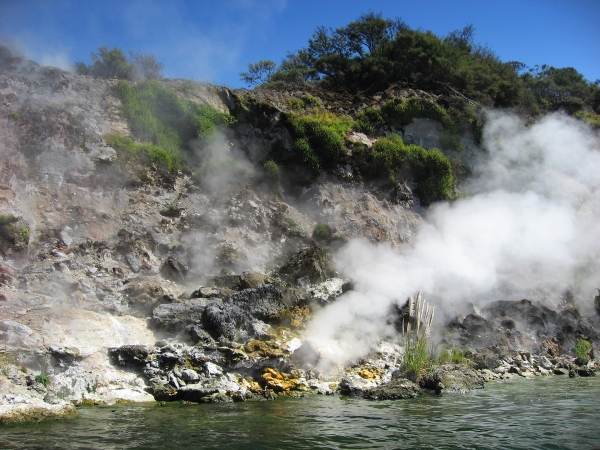This research project aimed to understand the causes behind differences in mercury in trout and other organisms in the Bay of Plenty/Te Arawa lakes—in particular what features of each lake explain why mercury in trout is higher in some lakes than in other lakes.
The issue
Mercury (Hg) biomagnifies in aquatic organisms, meaning that mercury concentrations in tissues of organisms are higher in animals that eat other animals and highest in top predators such as trout. The rate of mercury increase with increasing trophic level from herbivores to top predators is called biomagnification. The effects of environmental factors on biomagnification of mercury remain insufficiently known and need more study to guide management.
Various environmental variables have been shown to correlate positively (water temperature, organic matter in the sediment) or negatively (conductivity, pH, alkalinity, and concentrations of dissolved oxygen, Ca and SO4) with mercury in fish. On the other hand, the effect of algal biomass on mercury biomagnification and concentrations in fish appears more controversial. Concentrations of mercury in phytoplankton (floating algae), zooplankton and fish have been shown to be lower in eutrophic lakes (lakes with high algal biomass) than in oligotrophic lakes (lakes with low algal biomass) with similar mercury loading, as a result of dilution by higher algal biomass in the more eutrophic lakes.This has led to the conclusion that biomagnification of mercury is higher in oligotrophic lakes. However, others have shown higher mercury concentrations in fish in more eutrophic lakes compared with oligotrophic lakes with similar mercury loads. Therefore, whether and how algal biomass affects mercury biomagnification is not clear.
Consequently, the objectives of this study were: to compare mercury concentrations and mercury biomagnification in the food webs of three lakes in the Bay of Plenty Region that range from eutrophic, mesotrophic to oligotrophic, Lake Rotorua, Lake Rotomahana and Lake Tarawera, and examine links with environmental factors. These lakes are within the Taupo Volcanic Zone and have elevated mercury concentrations associated with natural geothermal inputs. There are marked differences between the lakes in terms of their physico-chemistry.
The solution
Samples of organisms were collected for analysis of mercury and isotopic ratios of nitrogen. Three species of fish, rainbow trout (Oncorhynchus mykiss), smelt (Retropinna retropinna), and common bullies (Gobiomorphus cotidianus), were collected. In addition, samples of several snail species, mussels, crayfish and other invertebrates, algae, and zooplankton were collected. Data on water temperature, organic matter in the sediment, conductivity, pH, alkalinity, and concentrations of dissolved oxygen, Ca, SO4, and chlorophyll a (a proxy for algal biomass), averaged over several years, were used to examine relationships with environmental factors. We used stable nitrogen isotopic ratios (δ15N) to examine the relationship between trophic position of organisms in the food web and their mercury concentration and to infer biomagnification of mercury in the food web. δ15N is a useful indicator of trophic position of organisms in food webs because it increases along the food chain from primary producers to the top predator. Food chain length was calculated as the difference in δ15N between algae and trout.
The results
The average concentration of mercury in trout in Lake Rotorua and Lake Rotomahana was about five times the maximum recommended level for consumption by the World Health Organization, suggesting less than 1 meal of fish (8 oz) per two months should be consumed. While there were differences between lakes in food chain length, Hg concentration in trout did not increase with food chain length, suggesting other factors were more important. Mercury biomagnification and mercury concentrations in trout were strongly influenced by environmental physico-chemistry and were highest in the eutrophic Lake Rotorua and least in the oligotrophic Lake Tarawera. In Lake Rotorua all eight measured physico-chemical variables had values more conducive to higher mercury in fish than in the other, less eutrophic lakes, supporting evidence for their effect in enhancing biomagnification and mercury concentrations in fish. In Lake Rotorua frequent anoxia occurs in bottom water, resulting in favorable conditions for methyl mercury formation and mercury transfer into and up the food chain.
Conclusions
Differences between the lakes in biomagnification and mercury concentration in trout correlated, as expected from previous studies, with eight physico-chemical variables including anoxia in bottom water, resulting in enhanced biomagnification of mercury in Lake Rotorua. Evidence was provided both by mercury biomagnification, ratios of mercury concentrations in trout and water, and by ratios of mercury concentrations between organisms, that biomagnification was greatest in eutrophic Lake Rotorua and least in oligotrophic Lake Tarawera.
The results regarding the relationship between mercury biomagnification and algal biomass conflict with expectations from earlier work which suggested biomass dilution by high algal biomass in eutrophic lakes to result in lower mercury biomagnification. Our results suggest that biomagnification of mercury in the food web and mercury in trout can be greater in a eutrophic than in an oligotrophic lake, depending on their physico-chemistry. The results may be explained in part by the fact that lower oxygen in bottom water and higher organic matter in the sediment, enhancing production of methyl mercury (MeHg), are typical features of highly productive lakes. Also higher bottom temperatures are often found in productive lakes because these are usually shallow, further enhancing methylation rates and its uptake by organisms. It is therefore not surprising to find high mercury concentrations in fish in lakes with high algal biomass. With global climate change this becomes increasingly more important because low oxygen conditions in bottom water in lakes are expected to become more common, which may result in enhanced production of MeHg and higher mercury concentrations in fish.
Further information
Full study published by Verburg P, Hickey CW and Phillips N. 2014. Mercury biomagnification in three geothermally-influenced lakes differing in chemistry and algal biomass. Sci. Total Environm. 493: 342–354. doi:10.1016/j.scitotenv.2014.05.097.
A summary was posted on the Lakescientist blogsite.

